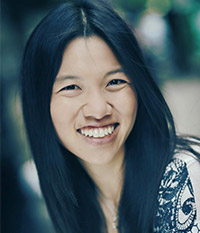As millennials move away from organized religion in favor of a more spiritual experience, new patterns of faith are forming across the city and, more broadly speaking, the world. We asked some of Chicago’s most prominent faith leaders for their thoughts on the changing landscape — and how they plan to keep the next generation engaged.
James Kang grew up as a pastor’s kid a couple of generations ago, attending church services and weekend retreats and surrounded by the accoutrements of the Christian faith. The environment felt familiar and comfortable, with praise songs wending their way into his memory. And yet. “I was churching a lot,” he says. “But I wasn’t really living out my faith.” Kang’s spiritual journey has undergone a series of evolutions, from the time he first came to a personal relationship with Jesus in 1982 to the programmatic elements of a megachurch to dedicating his life to global and local ministries to his current spiritual journey, in which he responds with “the balance of individual faith and community faith.” “I’m realizing that programs and activities are one part of our faith journey,” he says. “I think the other part of it is just relating with one another without any agenda, goals, or programs — in just sharing our lives and our struggles and being there for one another and praying for one another.”
The desire for a sense of authentic belonging extends across faiths, from Protestants to Catholics to Jews to Muslims, say multiple faith leaders throughout Chicago who are rethinking their own institutions in ways that will better engage their congregants. Clary Butler, an adjunct professor at Trinity Evangelical Divinity School in Bannockburn, a north Chicago suburb, and a former pastor of young adults, says, “The church can do better by listening. It confuses me when there’s someone hurting, and the church comes in and says, ‘Oh, we can fix that’ — without asking the person what they need or how their ache can be served. We’ve developed a ministry of busyness in which we feel if you’re serving in a mission field in El Salvador and providing clean water in Zambia, it’s like, ‘Oh, we’re doing the Lord’s work.’ Sometimes we’re just checking a box to make ourselves feel good. We’re not sitting with people who are hurting.”

Brandon Bernstein, campus rabbi at Northwestern Hillel, which is the center for Jewish life at Northwestern University in Evanston, says, “What people are really looking for, and this is my personal philosophy and theology coming in, we’re all looking for connection. We’re all looking for that sense of belonging and that connection to something greater.” The craving for community, he says, is marked in the internet age, which has magnified digital connections that often reveal themselves as much more illusory than face-to-face interactions. “It’s kind of like the difference between being hungry and eating a nice, home-cooked meal and eating a bunch of junk food and candy you bought at the store,” he says. “Sometimes you’re so ravenous you don’t have a choice but using the fast food option, so spiritually, you’re getting unhealthy.”
Rethinking Attendance Policies
Re-envisioning the roles of spiritual institutions comes as attendance at religious services has dropped with each subsequent generation, according to a Pew Research Center Religious Landscape Study conducted four summers ago. Drawing from a sample size of more than 35,000 adults, the study says 51 percent of those born between 1928 and 1945 attend services weekly, compared with 38 percent of baby boomers (born between 1946 and 1964), 34 percent of Generation X (born between 1965 and 1980), and 27 to 28 percent of millennials (born 1981-1996).
This does not mean, however, that people are becoming less spiritual. According to the study, 41 percent of religiously affiliated adults say they rely mainly on their religious beliefs for guidance on the difference between right and wrong, a figure up from 34 percent in 2007.
Practical reasons for the attendance dip can be attributed to a confluence of activities on Sunday mornings, especially those tugging young families to soccer games and karate classes. “One thing I’ve seen that has shifted is the local church going from being a priority to being an option,” Butler says. “Today, it seems as though the local church is treated like a fitness center, and people go if they have the time, but they don’t necessarily understand the necessity of being in community.” Other explanations stem from moral and philosophical issues. Deborah Jian Lee, host of “Kaleidoscope,” a podcast about identity, faith, and social engagement, says there’s a mistaken belief that young people do not attend religious institutions because they don’t care about their spiritual development. “I think one of the really common misconceptions is that people are leaving because they’re losing their faith,” says Lee, who’s also the Chicago-based author of “Rescuing Jesus: How People of Color, Women and Queer Christians Are Reclaiming Evangelicalism.” “What I’ve found is that’s just not true. People aren’t leaving because they’re losing their faith. They’re leaving because they’re looking to deepen their faith and engage their faith more deeply,” she says. “They’re leaving because a lot of them feel betrayed by the institutions that may have supported policies in the church, perhaps locally or nationally, that to them contradict the message of the gospel they’re following.”
Harnessing the Power of Technology
Father Tom Hurley, the priest at Old St. Patrick’s Church in Chicago’s West Loop, sees the way people practice their faith as qualitatively different from when he was ordained in 1993. “I think the formal institutional church isn’t as strong for people as it once was, perhaps a generation ago, two generations ago,” he says. “Yet I do think people are very engaged in the life of faith, but it might not necessarily be through the institution, particularly [not] through Sunday Mass.”
Jerry McQuay, senior pastor at Christian Life Center Church in the south Chicago suburbs and in Hammond, Indiana, expressed a similar sentiment about evangelical churches, saying his church is focusing on becoming integral to its community in different ways. “In the past, if people wanted to grow in their faith, if they wanted to express their faith, everything pretty much evolved around church programs at the building, and the only way for them to express their commitment was to attend,” he says. “Our goal is to get engagement Monday through Saturday and not just on Sunday mornings.” One way to accomplish that is to harness technology to create more than limited-character-count connections. For years, religious organizations have streamed and archived their services online. In the past year, however, McQuay’s church has been using an interactive community hub called Pray.com to share prayer requests throughout the week. Though congregants had been periodically sharing prayer requests over Facebook, “one of the unique things about Pray.com is that we have something just for our congregation, so everyone that participates in ours attends our church. They know the people with whom they’re sharing the prayer requests. One member will request prayer, and almost immediately, you’ll see about a dozen people respond. There’s the sense that we’re in this together, and the camaraderie.”
Believing in the Believers
Hurley says he’d like for Old St. Pat’s, as his church is commonly known, to be more intentional about creating community and small groups, much like evangelical churches have done. Several groups, he says, have already sprung up organically within the congregation. He adds, however, that the larger church needs to address systemic issues, particularly when it comes to the sexual abuse and misconduct scandals that have shaken people’s trust and undermined its credibility. “I think we’ll continue to atrophy, and we’ll continue to lose people until we see some real changes,” he says. “People who have been lifelong Catholics are fed up with the archaic model. There’s gotta be real change in terms of structural changes, systemic changes — we need more laypeople in leadership, for example. The credibility of leadership is compromised right now, and I think people are very anxious and very upset. They do want a faith community to connect with, but we need a change of leadership, and we need transparency.”

Closing the Diversity Gap
Across the board, there appears to be an overarching need for churches to address what Lee calls “inconsistencies between institutions and the faith that those institutions say they profess and how they actually practice, whether it’s in terms of institutional policy or public policies they support.” Churches, she says, need to listen to people who see contradictions between what they believe and how it’s expressed in the institutions and take those people seriously. Even more, these younger generations, especially those who are women and minorities, can see through efforts at diversity and inclusion that are made at a superficial or ornamental level, such as ensuring a certain number of people of color are in a church brochure.
“They’re looking for something that’s authentic,” Lee says of younger generations. “Leadership often limits who they let into leadership to people who all subscribe to the exact same beliefs. So it’s ‘OK, you can look different, but you have to believe exactly what we all believe here, the dominant theology, or the dominant culture.’ Authentic diversity means including people who not only bring a different identity or background but are really allowed to bring their whole selves.”
Extending Into the Community
Sandra Maria Van Opstal, who pastors at Grace and Peace Community Church in Chicago’s Hermosa and Austin neighborhoods, says urban churches, immigrant-centric churches, multiethnic churches, and global churches in Africa, Latin America, and the U.S. have experienced growth due to how they’re interwoven into their communities. “I definitely think we do church differently,” says Van Opstal, a Colombian-American who grew up in the northwest Chicago suburb of Buffalo Grove and who’s the author of “The Next Worship: Glorifying God in a Diverse World.” “The role of the church in immigrant and urban communities, in the life of the family and in the practice of faith — not only attending a service but in living life — is central,” she says. “Look at Asian immigrant churches or Latino immigrant churches. People find jobs in the church through networks. Families that move into apartments get their furnishings. It’s a place where you retain a language. We see more people come through our doors Monday through Saturday than we do on a Sunday.”
Grace and Peace Church and its community center have a food co-op, a summer program for kids, and bill payment assistance. Van Opstal says half the job responsibilities of the children’s pastor consist of community outreach. “The building of Grace and Peace Church and Grace and Peace Community Center is a place where people are doing life together, they’re accessing resources together,” she says. “So there’s a way in which the church functions that extends into the community, and I believe that is something that is incredibly compelling to this generation.”
Nurturing a Ministry of Activism
Amir Fulton, youth organizer and community outreach coordinator at the Inner-City Muslim Action Network, or IMAN, says for him, personal beliefs became intertwined with community activism. Amir, who’s 20, says when he was hospitalized because of behavioral issues and depression, he told God, “Get me out of this situation, and I will try to find you.” After a transfer to Gage Park High School on Chicago’s Southwest Side, he became enamored of activism and youth-led initiatives there, which addressed poverty, housing, food access, and police accountability. The activism led him to IMAN, which mobilizes people of all faiths around community issues, and he began asking staff questions about Islam. Fulton converted to Islam four years ago, and he sees it blending with the hip-hop he loves (he cites references to Islam by Muslim artists like Mos Def and Brother Ali) and his own narrative as a young black American man. “You begin to connect spirituality to the hip-hop culture,” he says. “That’s always big for me.” Community activism, he says, mirrors the core of his Muslim beliefs. “People forget,” he says, “that a lot of Muslims organize around justice reform and equal rights.”
Ultimately, spiritual leaders agree that this advocacy for equity, in both individual and institutional ways, should be an intrinsic part of faith institutions. “Jesus was a social justice guy,” says Hurley of Old St. Pat’s. “That was at the heart of who he was. I think the church being engaged in social justice issues is synonymous with what it means to be a Christian and what it means to be a person of faith.”
 Erin Chan Ding is an independent journalist and editor whose work has appeared in The New York Times, Midwest Living Magazine, the Chicago Tribune, Chicago magazine, Fit Pregnancy, Diversity Woman, Time Out Chicago, the Miami Herald, and the Los Angeles Times. She also writes for Northwestern University and The Navigators, a nonprofit ministry.
Erin Chan Ding is an independent journalist and editor whose work has appeared in The New York Times, Midwest Living Magazine, the Chicago Tribune, Chicago magazine, Fit Pregnancy, Diversity Woman, Time Out Chicago, the Miami Herald, and the Los Angeles Times. She also writes for Northwestern University and The Navigators, a nonprofit ministry.
She co-founded and co-leads Willow Mosaic, the racial reconciliation and racial justice ministry at Willow Creek Community Church, and also serves on Willow Global’s Latin America Board. She co-leads the National Freelance Affinity Group for the Asian American Journalists Association and is an active member of the American Society of Journalists and Authors. She served as the past president of the Chicago and Detroit chapters of the Asian American Journalists Association.
She’s run a 50-mile ultramarathon, two 50-kilometer ultramarathons, and 18 marathons and has started to invite her two kids into the running-obsessed lifestyle. She’s traveled to six of seven continents, often with her kids and husband, Charley. They live in suburban Chicago with their astonishingly long-lasting carnival goldfish, Fishy.

